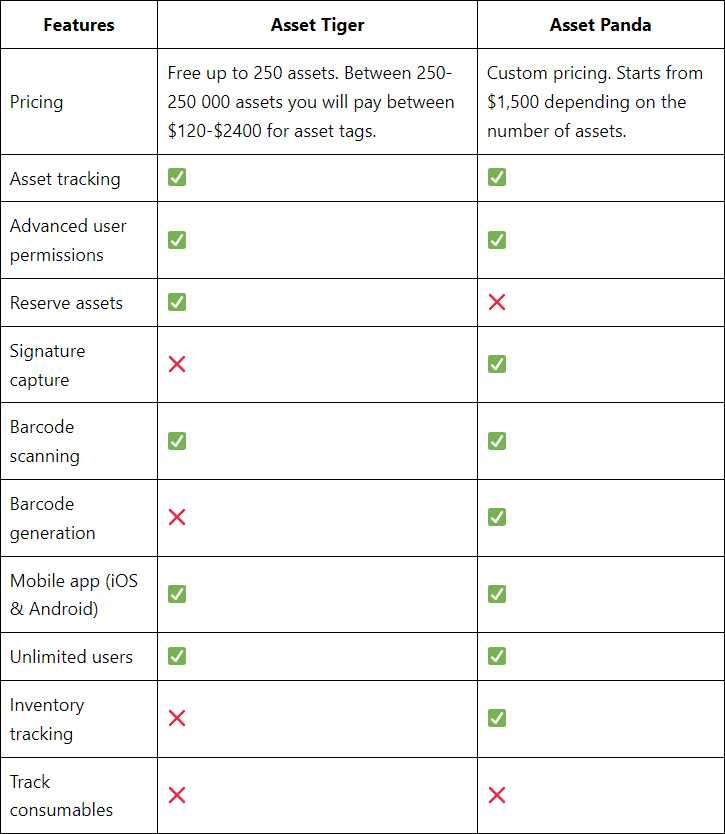Choosing the right asset management software can be a tough decision to make. You want software that’s easy to use, meets your business needs, and most importantly won’t break the bank.
At BlueTally, we understand your plight. This is why we’ll help you review two asset management software options, Asset Tiger vs Asset Panda.
We’ll look at the features, the price, and some of the pros and cons of both options, so you can understand what both have to offer.
Let’s get to it.
What is Asset Tiger?
Asset Tiger is a cloud-based asset management software created by MyAssetTag, a physical asset tag retailer. It was designed as a supplementary service to MyAssetTag customers so that they can track and manage their assets after buying tags from the retailer.

Features
With Asset Tiger, here’s what you can do:
- Barcode scanning
You can easily scan the barcodes of the asset tags you bought to track assets and update your asset register. - Asset check-in and checkout
You can see who has which asset at any given time, and print out reports to check which assets are due back - Maintenance scheduling
Schedule maintenance for assets and produce reports that show maintenance history
Pricing

Asset Tiger has a freemium model where you can manage up to 250 assets for free. There are annual subscription plans to buy asset tags, which is how you qualify to use the software if you have between 250-500 assets. You can either pay a $120 annual subscription for asset tags or buy asset tags worth a minimum of $180 to continue to use the software for free.
What is Asset Panda?
Asset Panda is a cloud-based asset management software that helps businesses to identify, track and manage assets. Clients include non-profit organizations, government, education, construction, healthcare, and religious institutions among others.
Features
- Assigned user permissions

This feature allows you to assign special permissions and access to assets based on user roles. This protects your software from unauthorized edits which can disrupt your processes.- IT asset tracking
With extensive third-party integrations you can combine your device and user information to understand what assets you have, who has which assets, and what condition they’re in. - Mobile audits
The mobile app allows you to conduct asset audits from anywhere. With full access to the dashboard, you can see any upcoming audits and get audit reports right on your phone.
Pricing

Asset Panda offers custom pricing depending on the number of assets you have. Pricing can be quite expensive starting from $1,500 and upwards.
Key differences
- Asset Tiger is free for up to 250 assets, whereas Asset Panda only offers a 2-week free trial if you’ve signed up for a demo.
- Asset Panda integrates with Okta, Azure active directory, Google workspace, and Zendesk among other 3rd party vendors. Asset Tiger offers no integrations so you will be forced to use what's available on the platform.
- Asset Panda has signature verification to ensure accountability when assigning or checking out assets. Asset tiger doesn’t have this feature.
- Asset Tiger doesn't offer barcode generation as a feature. Instead, you use the barcode from their asset tags. Asset Panda has barcode generation so you don't have to buy asset tags.
Feature comparison table

Which tool is best for you?
- Asset Tiger has positioned itself to be an affordable asset management software. Their platform gives great value for money especially if your business has limited resources.
- The platform is great if you want basic asset tracking and management and have less than 250 assets.
- Asset Tiger is ideal for small or medium businesses just getting started with asset management and have no extensive requirements from an asset management tool.
- Asset Panda offers a more comprehensive list of features that allow you to optimize asset management to save your business money.
- Asset Panda is designed to also help you track digital assets like software licenses, where you cannot put physical barcodes to track them.
Before you go, have a look at one last comparison of Asset Panda with its best alternative asset management software, BlueTally. BlueTally is free for your first 50 assets but plans are more affordable and you won’t have to commit to buying asset tags either.








